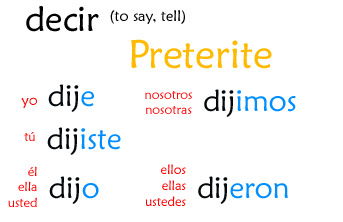This video lesson covers yet another irregular verb in the preterite: decir (to say, tell). Enjoy!
Feel free to leave questions/comments/suggestions about this video below.
For a summary on the preterite, check out the preterite conjugation sheet!
conjugation chart:

Vocabulario:
mi / mis – my
el padre – father, dad
la verdad – the truth
la señora – lady, woman
una mentira – a lie
mucho – a lot / much
algo – something
hola – hello, hi
demasiado – too [much]
la respuesta – the answer
el número de teléfono – telephone number
su / sus – his, her, their
————————–
Related video(s)

8 Responses
Thanks so much, these are the best spanish lessons ever!
I thought that a persons name was at the end of a sentence when it was in the form of a question. I am wondering if “Te” is the reason why.
The Spanish language is very flexible. It isn’t like English where you’re limited to subject/verb placement.
In Spanish… I can put the subject anywhere in the sentence and it will still make sense.. with questions there is also that same flexibility.
So I believe the sentence was:
¿Te dijo Ana su número de teléfono?
This could also be:
¿Ana te dijo su número de teléfono?
or
¿Te dijo su número de teléfono Ana?
All would make sense and some might be preferred from one person to another.
-Sr. J
what are the stages 1 to 10 to becoming totally fluent in spanish?
Eres el mejor de todos los instructores. Tienes un P.O. Box puedo enviar un cheque? No utilizar PayPal.
I thought you needed to use the personal “a” before Ana ( Evita)
Like:
Te dijo su numero de telephono a Ana (evita)?
Te dijo a Ana su numero telepone?
If not why in this case?
Good question!
You would need an “a” if Ana was the one that you told the information TO. But remember that Spanish word order will be something that will throw you off if you don’t look at other clues for meaning in the sentence. 😉
Let’s look at the sentence:
Te dijo su número de teléfono Ana…
To you she said her number of telephone Ana
Meaning, Ana told you her telephone number. Ana is the subject, not the object. Meaning she is WHO calls, thus no a.
We only place the “a” before the name if that person is the object (direct or indirect).
Hope that helps!
I’m not sure if you will get this or not 🙂